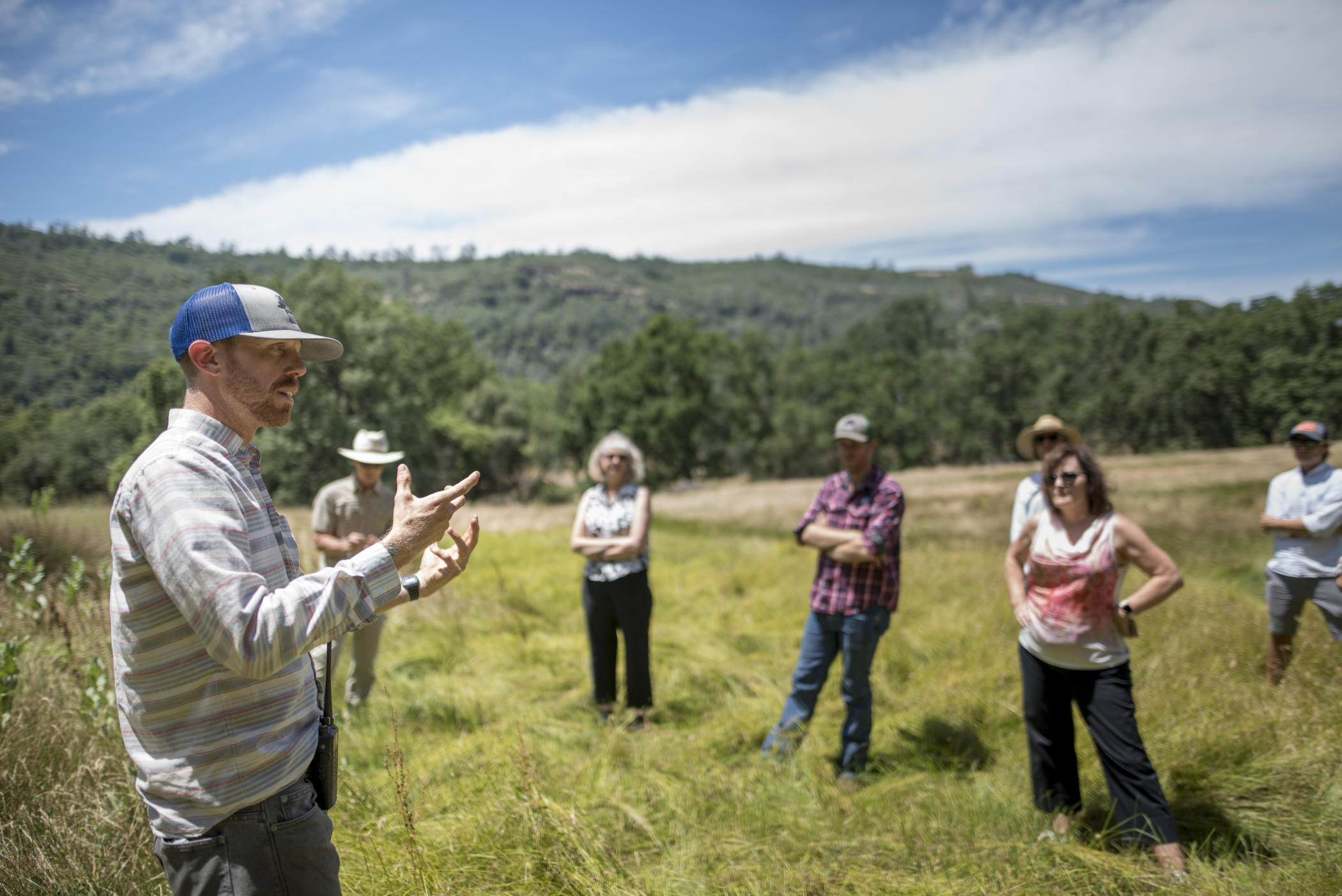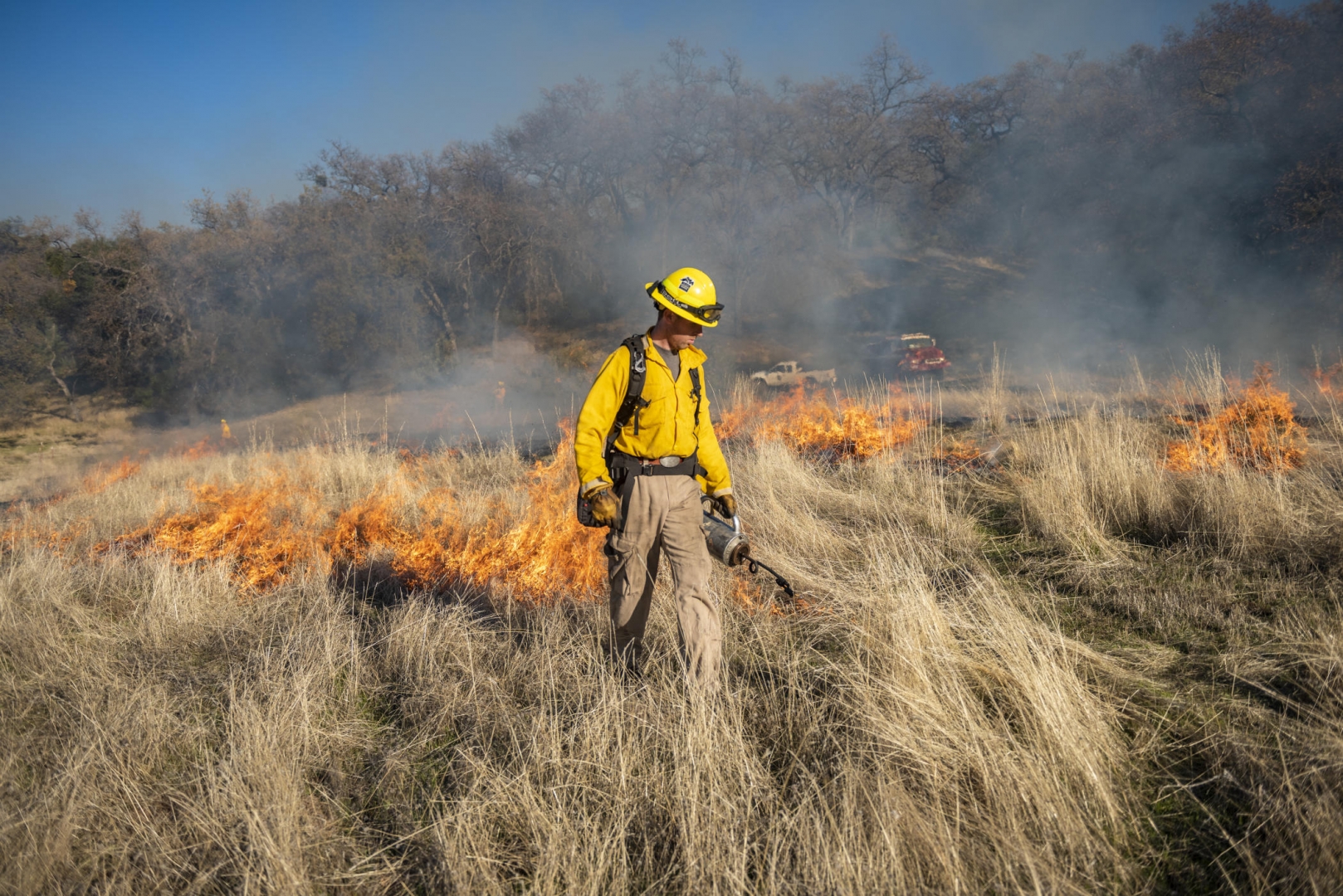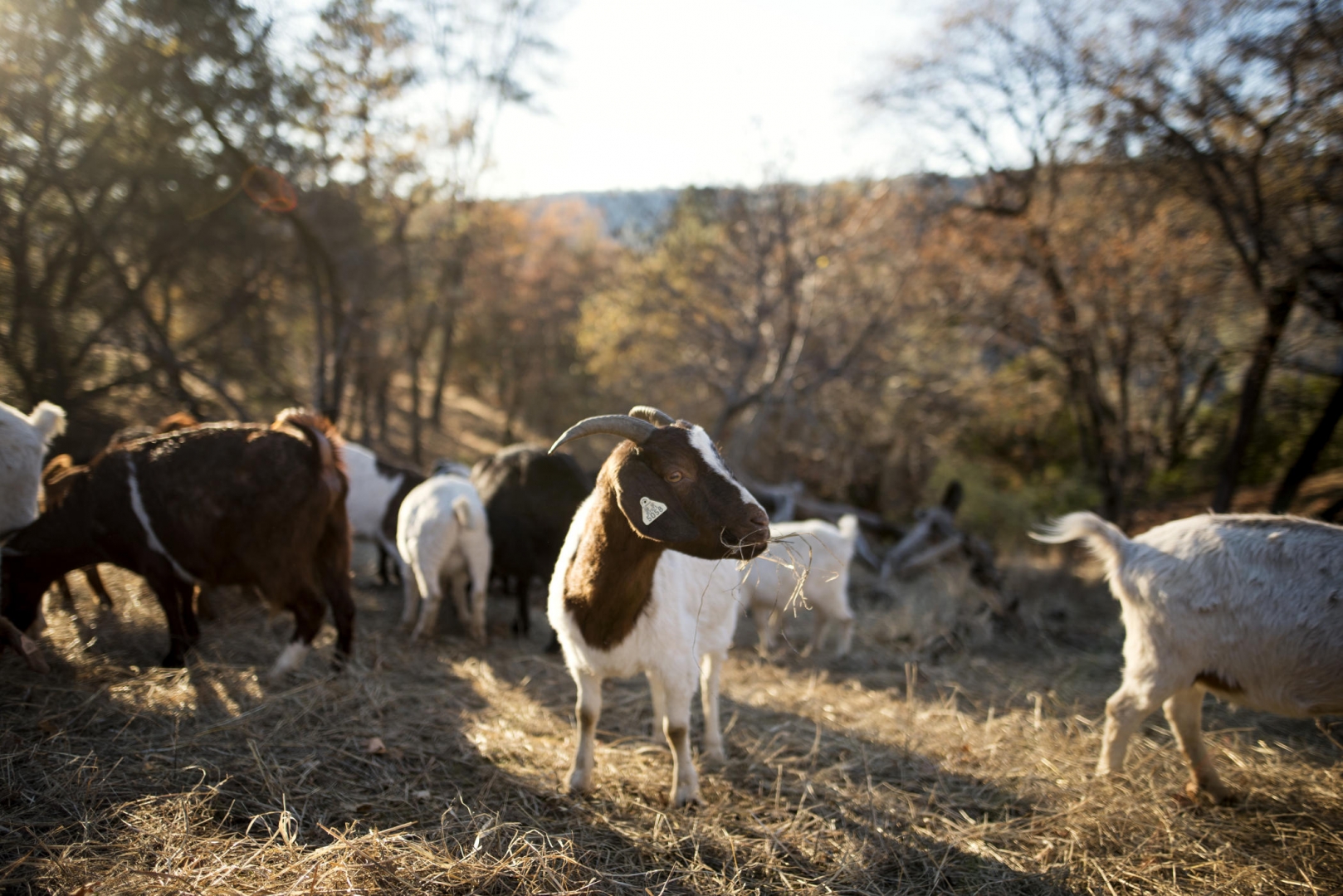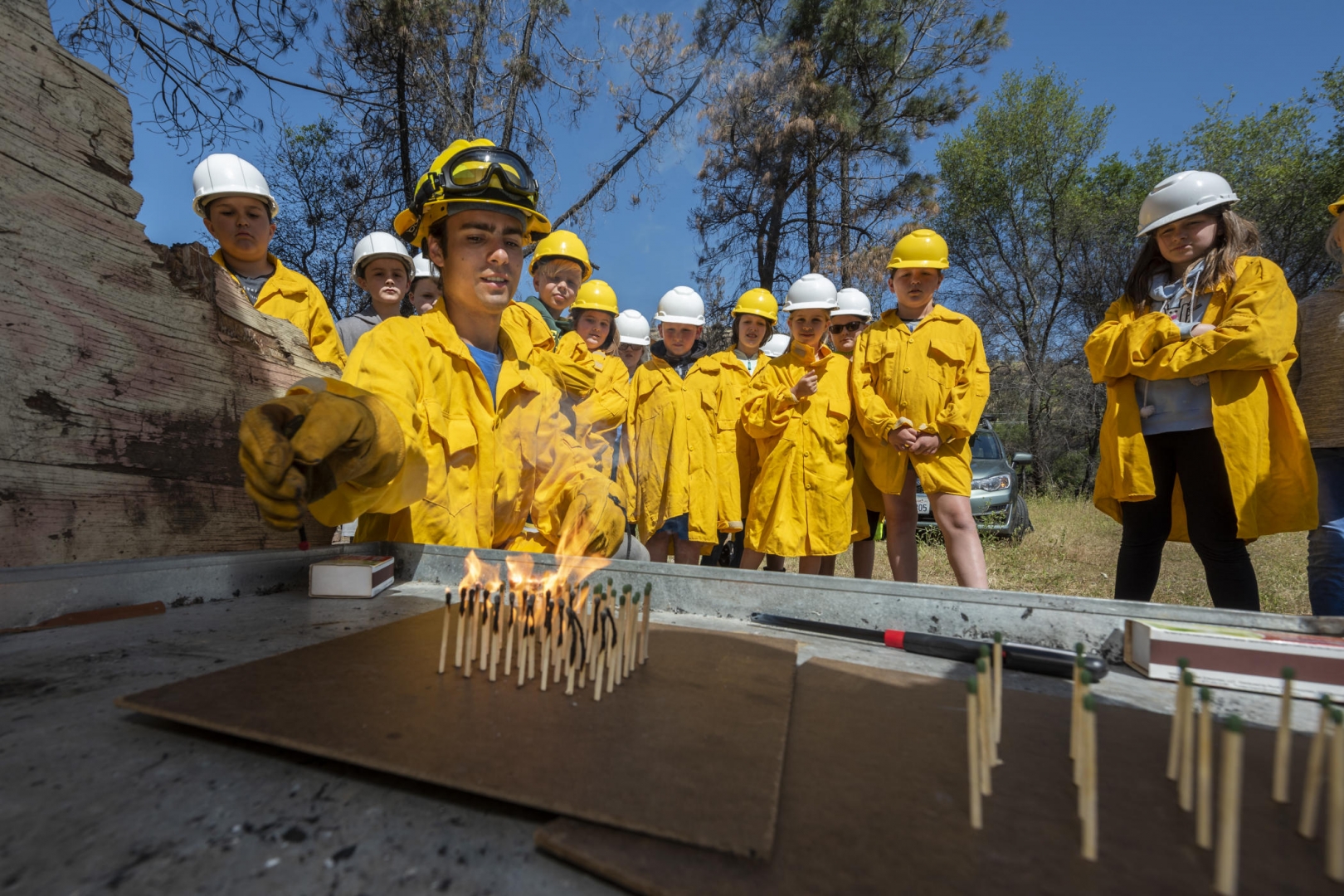Warriors Against Wildfire

BCCER Director Elie Goodsell (left) provides a tour to faculty and staff at the Big Chico Creek Ecological Reserve as they learn about all of the work being done post-Camp Fire on and around the Reserve for Teaching & Researching the Camp Fire: Tour of the Big Chico Creek Ecological Reserve program on Monday, June 24, 2019 in Chico, Calif. (Jessica Bartlett/University Photographer/CSU Chico)
Amid the rise of megafires, the national conversation is growing louder around ways to temper and prevent devastating wildfires.
At the Big Chico Creek Ecological Reserve (BCCER), those talks—and ensuing action—have been taking place for two decades. Ever since the University took stewardship over the 3,950 acres east of Chico, BCCER’s land managers have engaged in research and practices to maintain its wildlands in ways that reduce fire danger, improve its ecosystem, and honor indigenous culture.
“We strive to use ourselves as a training ground for best practices that can reverberate throughout California,” said Eli Goodsell, director of the University’s Ecological Reserves. “Our goal is to provide that learning laboratory around the tie between forest health and cultural and ecological goals.”
The BCCER recently hosted more than 20 Chico State faculty and staff on a tour as part of the Teaching the Camp Fire working group. With responsible research and education as their goals, the group sought to witness firsthand the effectiveness of BCCER’s current practices and learn about its ambitions for the future.
“We look to do a project with a 50-year lens, not a one-year or one-season lens,” Goodsell said. “We have the opportunity to have a microphone to really pass on some of our knowledge.”
This is especially critical as other institutions look to the University for its expertise in the wake of the Camp Fire, said Megan Kurtz, the University’s liaison to the Camp Fire Long-Term Recovery Group. Dozens of universities across the nation have descended on Paradise and neighboring burned-over communities with plans of researching myriad facets of the disaster, and are reaching out to Chico State for guidance on the long-term logistics and ethics of their studies.
“We are writing the playbook,” Kurtz said. “And a lot of people are going to be watching what we are doing as we turn what we learn over to the public.”

One area where BCCER stands to be a training ground is prescribed fire. It’s one of the most common tools employed on the reserve—and one it most wants to spread awareness of—because it is an incredibly effective, economical, environmentally beneficial, and efficient way to reduce fuels, Goodsell explained as part of the tour.
“It’s not ‘how do we prevent fire’ but ‘how do we live with fire and use it in our educational and learning goals,’” he told the group. “The conversation has to be not to be afraid of fire but ‘how do we use fire?’”
Mere weeks after the 153,336-acre Camp Fire was finally contained, students, wildland firefighters, and volunteers from the non-profit Terra Fuego and other agencies led a prescribed burn on BCCER land. Drip torches in hand, they walked through meadows and underneath the sprawling oaks, lighting off the dry grasses as they went.
Months later, Goodsell could point to the burn area and visibly demonstrate how it had transformed with the help of fire. Instead of grasses teasing into the canopy of low-hanging trees, natural accumulations of dead branches, and vegetation so thick it looked impassable, clear lines of sight stretch across the landscape in areas that had been touched by flame.
Similarly, 20 years ago, one meadow close to office headquarters was choked with nonnative star thistle. BCCER crews have been working to eradicate it year by year. In one patch, they used simply fire and watched as the star thistle perplexingly returned along with lots of native grasses. In another patch, they witnessed a near-halting of vegetation after fire treatment was followed with a mower just before the star thistle set its blooms. And where simply a mower was used, they watched as it grew thick with annual, nonnative grasses.
By examining the treatments’ outcomes over multiple years, students and land managers can learn what the most efficient and effective practice will be far into the future, and share that knowledge far and wide.
“We are not doing our jobs if all we are doing is managing 4,000 acres,” Goodsell said. “We need to permeate that knowledge to 4 million acres.”
This year, prescribed fire was used on more than 75 acres to reduce fuels, prepare for fall burning, and study the control of invasive medusahead rye grass. The reserve also partnered with Cal Fire to manage vegetation on another 450 acres, and used 490 goats to trim down another 50 acres, with students working closely on every project.

Partnerships are a critical component at the heart of all this work. The Mechoopda and Concow tribes have been sharing their indigenous knowledge about fire and ecosystems while reconnecting with their ancestral landscape at the reserve.
All of this serves not only an academic purpose but an applicable one as well. Upcoming BCCER projects include a partnership to create an early warning system for fires along the ridgetop and creating fuel breaks from Cohasset to Forest Ranch to prevent rural wildfires from racing across the landscape, to protect not only the reserve but all residents in its neighboring communities.
Students take an active role in it all, embarking on research projects, working as land managers, and applying what they are learning in the classroom to the landscape. Ultimately, this experience will be a launch pad for their careers and hopefully take this knowledge to a widespread level as students take it with them into their roles in recreation, forestry, firefighting, and so much more, Goodsell said.
“Where we can grow is providing those experiences to the next generation of land managers,” Goodsell explained to the tour group. “We want to provide experience here that looks at how we live with fire in ways that are ecologically beneficial.”
The reserve has become an outdoor classroom for many outside the University, as well. BCCER has also hosted training for firefighters from Nevada, Alaska, Arizona, and other states across the west on how to use fire. And this year, the Ecological Reserves will be hosting a prescribed fire workshop for private landowners to teach how strategic burning can reduce wildfire risk.
Additionally, the Ecological Reserves recently was awarded a K–12 grant with the California Fire Safe Council to write fire ecology into the educational curriculum statewide and integrate the concept to outdoor education. This spring, Paradise Elementary students toured the University’s Butte Creek Ecological Preserve, which was burned over by the Camp Fire, to learn about fire ecology and healthy ecosystems.

“We view our outdoor education program as integral to everything we do,” Goodsell said. “It’s creating our next generation of CSU, Chico college students, fire professionals, and scientists. When somebody decides they want to be a biologist, it’s not their freshman year of college—it’s when they are 8 years old, pull up a plant, and wonder why it blooms this time of year. Asking those questions at a young age and recognizing opportunities to get careers in those areas are one of the biggest benefits we can see.”
Down near the banks of Big Chico Creek, a few acres of Scottish broom had grown rampant. The bush is eye-catching, with its dark green stems and sunshine yellow blossoms, but it’s also an invasive species and highly flammable, known not just to carry fire but also to propel it high into the tree canopy.
As BCCER land stewards worked to eradicate it, they invited nearby neighbors in Forest Ranch to witness a demonstration. For a final show, they lit a pile of removed broom on fire and watched the flames shoot skyward. The small inferno inspired the private landowners to start widespread Scottish broom eradication in the adjacent community.
Spotting a slender sprout about 8 inches tall in the soft soil near the bank of Big Chico Creek, Professor Emeritus Paul Maslin, a dedicated BCCER volunteer and its retired reserve field director, stoops, yanks it out, and holds it out for the visitors to see, the uprooted plant dangling from his hand.
“You have to think maintenance,” Maslin said, “not just restoration.”


